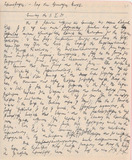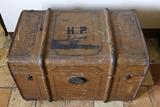Photograph of Thomas Mann in Sanary-sur-Mer (1933)
Photograph of Thomas Mann in Sanary-sur-Mer (1933)
Mein Heimweh nach dem alten Zustande [München] ist übrigens gering. Ich empfinde fast mehr davon für Sanary, das mir im Rückblick als die ‚glücklichste’ Etappe dieser 10 Monate erscheint, und nach meiner kleinen Stein-Terasse am Abend, wenn ich darauf im Korbstuhl saß und die Sterne betrachtete.
[In actual fact, I do not feel much homesickness when I think of the old times [Munich]. I almost feel more attached to Sanary: my small stone terrace in the evening, sitting in the wicker chair and watching the stars. In hindsight seemingly the ‘happiest’ stage of these 10 months. (ed. trans.)]
Thomas Mann, diary entry, 31 December 1933
In summer 1933, following stopovers in Arosa, Lugano and Bandol, the emigrated writer Thomas Mann spent several weeks in Sanary-sur-Mer before he decided to rent a house in the Swiss town of Küsnacht.
In the first few months after the Nazis gained power in Germany, the little town on the French coast of the Mediterranean Sea became a meeting point for emigrated artists and intellectuals. As well as Mann’s older brother Heinrich Mann, the writers Arnold Zweig, Lion Feuchtwanger and Bertolt Brecht settled there temporarily. Mann himself moved into the villa “La Tranquille” on 12 June 1933, where he remained until 22 September that year. He commented in his diary about how he believed they would be happy living in the house and that a private existence did him the world of good after four months of living in hotels. The writer bought himself a Peugeot and new clothes in Sanary-sur-Mer. During his stay he read works by Tolstoy and Adalbert Stifter; his own literary production, however, ground to a halt. He commented in his diary entry from 3 July that his story-telling efforts were of no avail and he lacked joy and energy.



